Calendula flower which is scientifically called Calendula officinalis, while commonly known as marigold or pot marigold, is a bright and cheerful flowering plant that belongs to the Asteraceae family. Native to Southern Europe, it has been cultivated and naturalized in various regions around the world. Calendula is renowned for its vibrant blooms, herbal properties, and ornamental value.
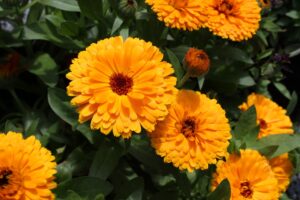
Calendula is an annual or short-lived perennial herbaceous plant. Typically, calendula plants reach a height of 12 to 24 inches (30 to 60 cm), though this can vary depending on the cultivar and growing conditions. The leaves of calendula are lance-shaped, slightly hairy, and possess a light green color. They are alternately arranged along the stems.
Calendula flowers have a distinctive daisy-like appearance, with a prominent central disk and radiating petals. The petals are often deeply notched or toothed, giving them a fringed or ruffled appearance. The most common colors for calendula flowers include shades of bright orange and yellow. Some cultivars may also exhibit apricot or cream-colored blooms. Calendula is known for its long blooming season, typically from late spring through fall. In favorable conditions, it may continue to flower throughout the growing season.
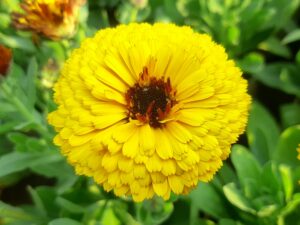
Cultivars of Calendula Flower
Calendula is a popular herbaceous plant known for its bright and cheerful flowers. There are several cultivars of calendula, each with its unique characteristics. Here are some notable cultivars of calendula:
Calendula officinalis ‘Pacific Beauty’: This cultivar is known for its large, double flowers in shades of orange and yellow. ‘Pacific Beauty’ is a prolific bloomer and often used for ornamental purposes.
Calendula officinalis ‘Bon Bon Mix’: The ‘Bon Bon Mix’ features compact plants with vibrant, double flowers in various shades, including orange and yellow. It’s well-suited for container gardening and borders.
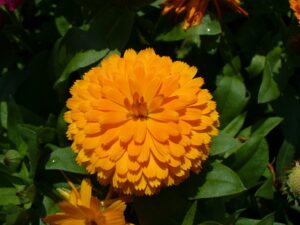
Calendula officinalis ‘Touch of Red Mix’: As the name suggests, this cultivar offers flowers with a touch of red in the center, adding an extra dimension to the typical orange and yellow hues of calendula blooms.
Calendula officinalis ‘Snow Princess’: This cultivar stands out with its creamy white flowers, a departure from the typical orange and yellow shades of calendula. ‘Snow Princess’ adds a touch of elegance to gardens and arrangements.
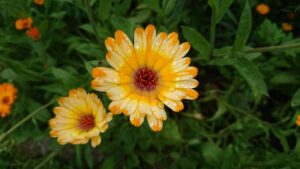
Calendula officinalis ‘Radio’: ‘Radio’ is recognized for its apricot-colored petals with a dark center. The warm tones make it an attractive choice for both garden borders and cut flower arrangements.
Calendula officinalis ‘Orange King’: ‘Orange King’ is a classic calendula cultivar with large, fully double, orange-gold flowers. It’s a popular choice for both garden beds and herbal uses.
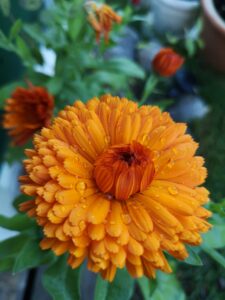
Calendula officinalis ‘Citrus Cocktail’: This cultivar features vibrant flowers in citrus-inspired shades, including oranges and lemons. The mix of colors adds a playful and lively element to the garden.
Calendula officinalis ‘Apricot Twist’: ‘Apricot Twist’ is known for its unique apricot-colored blooms with a hint of pink. The flowers have a subtle twist in their petals, adding interest to the overall appearance.
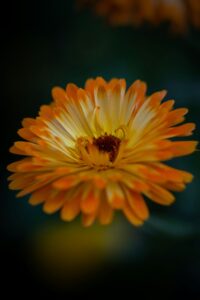
When choosing a calendula cultivar, consider factors such as color preferences, plant size, and growth habits to suit your garden or landscaping needs. Additionally, calendula is valued not only for its ornamental appeal but also for its herbal and medicinal uses.
Sunlight Requirement of Calendula Flower
Calendula plants generally prefer full sun to partial shade. While calendula can tolerate partial shade, it tends to thrive in full sun conditions. Full sun exposure means the plant receives at least 6 to 8 hours of direct sunlight per day.
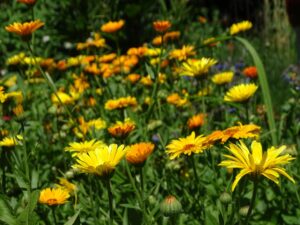
Temperature and Humidity Requirements of Calendula Flowers
Calendula is a cool-season plant that thrives in moderate temperatures. It prefers temperatures between 60°F to 70°F (15°C to 21°C) for optimal growth. Calendula can withstand light frosts, and in some regions, it may continue to bloom during the winter in milder climates. Calendula is relatively tolerant of different humidity levels.
Soil Requirement of Calendula Flower
Calendula is not particularly demanding when it comes to soil requirements, and it can adapt to various soil types. While calendula is adaptable to different soil textures, loamy soil with a good balance of sand, silt, and organic matter is ideal. Loamy soil provides a combination of good drainage and water retention. Calendula is not overly sensitive to soil pH and can tolerate a range of pH levels. However, a slightly acidic to neutral pH (around 6.0 to 7.0) is generally suitable for most garden plants, including calendula.
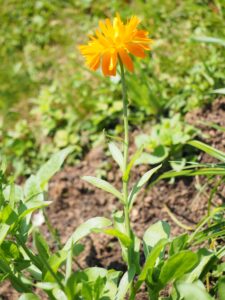
Calendula can also be successfully grown in containers. Use a well-draining potting mix suitable for container gardening. Ensure the containers have drainage holes to prevent waterlogging. Amend the soil with organic matter before planting to improve fertility and structure.
Propagation of Calendula Flowers through Seeds
Calendula officinalis is commonly propagated through seeds, and it is a straightforward process. Here’s a guide on propagating calendula flowers from seeds:
Obtain fresh calendula seeds from a reputable source or collect them from mature flower heads in your garden.
Fresh seeds are more likely to germinate successfully.
Calendula seeds can be sown directly in the garden or started indoors, depending on your preference and growing conditions.
If starting indoors, use seed trays or pots filled with a seed-starting mix.
Plant the seeds at a depth of about 1/4 inch (6 mm) in the soil or seed-starting mix.
Ensure that the soil or seed-starting mix is well-draining. Calendula prefers a moderately fertile, loamy soil.
Calendula seeds typically germinate within 7 to 14 days under optimal conditions.
Maintain a consistent temperature of around 60-70°F (15-21°C) for successful germination.
Calendula seeds do not require complete darkness for germination. Provide indirect light or place the seed trays in a location with bright, filtered sunlight.
Once the seedlings have developed a couple of sets of true leaves and are sturdy enough, they can be transplanted.
If started indoors, transplant the seedlings into larger pots or directly into the garden.
If sowing directly in the garden, choose a well-prepared bed with good drainage.
Space the plants according to the recommended spacing for calendula, usually around 12 to 18 inches apart.
Keep the soil consistently moist during the germination period and afterward. Calendula prefers regular watering but does not tolerate waterlogged conditions.
Calendula is known for its ease of cultivation and quick germination, making it a great choice for gardeners looking to grow vibrant and cheerful flowers. Following these steps will help you successfully propagate calendula through new seeds and enjoy their colorful blooms in your garden.

Water Requirement of Calendula Flowers
Water newly planted calendula seeds or seedlings regularly to keep the soil consistently moist until they establish a strong root system. During the first few weeks after planting, aim to provide a steady supply of water to encourage healthy growth. Once calendula plants are established, they become more tolerant of dry conditions. Allow the soil to dry out slightly between waterings. Calendula prefers well-draining soil, and waterlogged conditions can lead to root rot. Water calendula when the top inch (2.5 cm) of the soil feels dry to the touch.
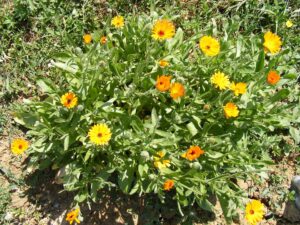
Fertilizer Requirement
Calendula is generally a low-maintenance plant that doesn’t have high fertilizer requirements. However, providing some nutrients can promote healthier growth and more prolific flowering. Before planting calendula, incorporate organic matter, such as compost, into the soil to provide a nutrient-rich foundation. If the soil is poor or lacks organic matter, you can apply a balanced, all-purpose fertilizer at planting time to give the plants a good start.
Consider using a slow-release fertilizer to provide a steady supply of nutrients over an extended period. This can reduce the need for frequent applications. Choose a fertilizer with a balanced N-P-K ratio, such as 10-10-10. During the growing season, you can use a diluted liquid fertilizer every 4-6 weeks to supplement nutrients. Follow the instructions on the product label for proper dilution.
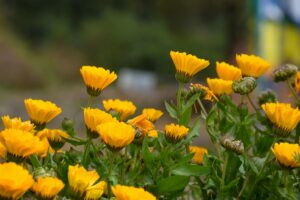
Deadheading of Calendula flowers
Deadheading is the practice of removing spent or faded flowers from plants. Calendula flowers deadheading can encourage continuous blooming and maintain a neat appearance. Begin deadheading when the first flush of blooms starts to fade. Regular deadheading throughout the growing season can prolong the flowering period. If you want to prevent self-seeding or if the goal is to encourage continuous blooming, remove not only the faded petals but also the developing seed heads.
Ornamental Uses of Calendula flowers
Calendula flowers are not only popular for their medicinal and culinary uses but also for their ornamental qualities. Here are some ornamental uses of calendula flowers:
Garden Borders and Edges: Calendula plants, with their bright and cheerful blooms, are often used to create borders and define the edges of garden beds. Their vibrant colors add visual appeal and create a welcoming atmosphere.
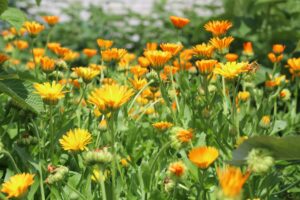
Container Gardens: Calendula is well-suited for container gardening. Planting them in pots or hanging baskets adds a burst of color to patios, balconies, and other outdoor spaces. Their compact growth habit makes them ideal for smaller containers.
Cut Flower Arrangements: The long stems and vibrant hues of calendula flowers make them excellent additions to cut flower arrangements. Harvesting the blooms for bouquets allows you to bring their sunny colors indoors.
Companion Planting: Calendula is known for its ability to attract beneficial insects, such as ladybugs and hoverflies, to the garden. Its presence can help deter certain pests and promote a healthy garden ecosystem.
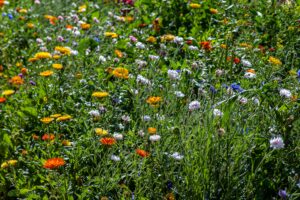
Colorful Mass Plantings: Planting calendula in mass groupings can create a striking visual impact. The collective display of bright orange, yellow, or other colors provides a lively and dynamic focal point in the garden.
Pollinator Gardens: Calendula flowers are rich in nectar and attract pollinators like bees and butterflies. Including them in a pollinator garden helps support these essential insects and contributes to overall garden biodiversity.
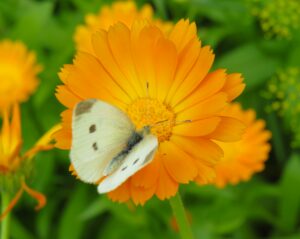
Edging Along Pathways: Planting calendula along garden pathways or walkways adds a charming and whimsical touch. The flowers spill over the edges, softening the hardscape and creating a welcoming entrance.
Seasonal Displays: Calendula’s ability to bloom over an extended period makes it suitable for seasonal displays. Whether in spring, summer, or fall, the flowers can be featured in different parts of the garden for continuous color.
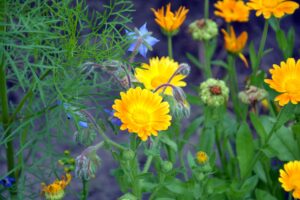
Cottage Gardens: With their cottage garden charm, calendula flowers are a staple in traditional cottage garden designs. They complement other cottage garden favorites, such as roses, lavender, and daisies.
Naturalizing Areas: Allowing calendula to naturalize in certain areas of the garden can create a casual and informal look. Their self-seeding nature can lead to delightful surprises in subsequent growing seasons.

Calendula’s versatility, easy cultivation, and vibrant blooms make it a versatile and valued addition to ornamental gardens. Whether used in formal or informal settings, calendula brings a touch of brightness and joy to outdoor spaces.


